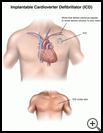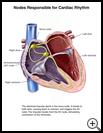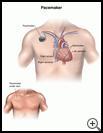
Pacemaker or Implantable Cardioverter Defibrillator (ICD) Surgery
________________________________________________________________________
KEY POINTS
- Pacemakers and ICDs are small battery-powered devices that help your heart beat in a normal rhythm. Pacemaker or ICD surgery is a procedure done to pass the wires through a vein and into your heart. The wires are attached to the pacemaker or ICD device, which is placed under the skin in your chest or belly.
- Tell your healthcare provider about all medicines and supplements that you take. Ask your healthcare provider if you need to avoid taking any medicine or supplements before the procedure.
- You will need regular follow-up visits with your healthcare provider so the device can be monitored. You will learn how to check the function of the device at home and send information to your healthcare provider through a telephone.
- Tell all of your healthcare providers and dentists that you have a pacemaker or an ICD. Carry an ID card or wear a medical ID bracelet or necklace to let emergency healthcare providers know that you need special care.
________________________________________________________________________
What is pacemaker or ICD surgery?
Pacemakers and ICDs are small battery-powered devices that help your heart beat in a normal rhythm. A pacemaker uses wires to deliver low-level electrical signals to the heart, causing a regular heartbeat. An ICD works like a pacemaker most of the time. Also, when needed, it sends a small electric shock to the heart to stop a life-threatening heart rhythm and restart a healthy rhythm.
Pacemaker or ICD surgery is a procedure done to pass the wires through a vein and into your heart. The wires are attached to the pacemaker or ICD device, which is placed under the skin in your chest or belly. Your healthcare provider sets it to monitor your heart rhythm and send electrical signals to your heart, if needed. You will be able to feel the device under your skin. It’s about the size of a large watch.
Before you have a permanent pacemaker or ICD, you may need a temporary pacemaker. The temporary device is larger and will be placed near you at your bedside or in a pocket of your hospital gown.
When is it used?
Normally, an electrical signal in your heart starts each heartbeat, causing the heart muscle to squeeze (contract). This signal starts in the upper right chamber of the heart (the right atrium). The signal then follows normal pathways to the upper left atrium and to the lower chambers of the heart (the ventricles). When your heart cannot beat regularly because of a problem with the electrical signal or damage to your heart, you may need a pacemaker or an ICD. An ICD can be life saving if you have a life-threatening heart rhythm or if your heart stops suddenly.
Ask your healthcare provider about your choices for treatment and the risks.
How do I prepare for this procedure?
- Make plans for your care and recovery after you have the procedure. Find someone to give you a ride home after the procedure. Allow for time to rest and try to find other people to help with your day-to-day tasks while you recover.
- You may or may not need to take your regular medicines the day of the procedure. Tell your healthcare provider about all medicines and supplements that you take. Some products may increase your risk of side effects. Ask your healthcare provider if you need to avoid taking any medicine or supplements before the procedure.
- Tell your healthcare provider if you have any food, medicine, or other allergies such as latex.
- Follow your provider's instructions about not smoking before and after the procedure. Smokers may have more breathing problems during the procedure and heal more slowly. It is best to quit 6 to 8 weeks before surgery.
- Your provider will tell you when to stop eating and drinking before the procedure. This helps to keep you from vomiting during the procedure.
- Follow any other instructions your healthcare provider may give you.
- Ask any questions you have before the procedure. You should understand what your healthcare provider is going to do. You have the right to make decisions about your healthcare and to give permission for any tests or procedures.
What happens during the procedure?
The procedure is done at the hospital or a surgery or cardiac center.
You will be given medicine to keep you from feeling pain during the procedure. Usually a local anesthetic is given to numb the area where the device will be placed, along with medicine to help you relax.
Your provider will make a small cut in the skin of your chest or upper belly. Small wires will be passed through a vein to your heart and then tested to check their position in your heart. A small pocket will be made under your skin for the device. The wires will be connected to the device and tested. If you have an ICD, your provider will give you medicine to help you fall asleep before the test so you won't feel the shocks given by the ICD during the test.
Your provider will then close the cut and set the device to help control your heart rhythm.
What happens after the procedure?
After the surgery you will stay in a recovery area for at least a few hours and then you will usually stay in the hospital overnight. Depending on why you need a pacemaker or ICD, you may need to stay in the hospital for a few days.
Before you leave the hospital, your healthcare provider will check your pacemaker or ICD to make sure it is working. If needed, your provider will adjust the device. The adjustment is painless and usually takes just a few minutes.
Follow your healthcare provider's instructions. Ask your provider:
- How long it will take to recover
- If there are activities you should avoid and when you can return to your normal activities
- How to take care of yourself at home
- What symptoms or problems you should watch for and what to do if you have them
Make sure you know when you should come back for a checkup. You will need regular follow-up visits with your healthcare provider so the device can be monitored. Monitoring shows whether the device is sensing your heartbeat properly, how many shocks have been delivered if you have an ICD, and how much power is left in the batteries. The batteries last about 6 to 10 years. When the batteries have run down, you will need minor surgery to replace the device.
How can I take care of myself when I have a pacemaker or ICD?
You will learn how to check the function of the pacemaker or ICD at home and send information to your healthcare provider through a telephone.
Some equipment may interfere with how the pacemaker or ICD works, such as:
- Cell phones. Keep your cell phone and other mobile devices at least 6 inches away from your device. When you are talking on your cell phone, hold it on the opposite side of the body from your device. When your phone is turned on, do not carry it in a shirt pocket.
- Power equipment. The device may not work properly near power-generating equipment and arc-welding equipment.
- Magnetic resonance imaging (MRI). MRI uses a powerful magnet to produce images of internal organs. The magnet can interrupt the pacing rate of the device.
- Radiation. X-rays generally do not affect the device, but radiation used to treat cancer may damage the device.
- Short-wave or microwave diathermy (deep heat treatment). The signals used for this treatment may damage the device or affect how it works.
- Shock wave lithotripsy to dissolve kidney stones. The shock waves may interfere with the device.
The equipment listed below generally does not damage pacemakers or ICDs and does not affect how well they work:
- CB radios and ham radios
- Electric drills
- Electric blankets and heating pads
- Electric shavers
- Metal detectors (passing through the metal detector at airports will not damage a pacemaker, but the metal in it may sound the alarm)
- Microwave ovens
- Televisions and remote controls
Tell all of your healthcare providers and dentists that you have a pacemaker or an ICD. Carry an ID card or wear a medical ID bracelet or necklace that says you have a pacemaker or an ICD. If you become unconscious, the ID will let emergency healthcare providers know that you need special care.
What are the risks of this procedure?
Every procedure or treatment has risks. Some possible risks of this procedure include:
- You may have problems with anesthesia.
- You may have infection or bleeding.
- The wires could puncture one of the lungs, the vein, or the heart.
- The device may need to be replaced if it stops working properly.
- The wires may come loose or break.
The most common problem with an ICD is that it sometimes gives shocks when you don’t need them. You will feel each shock even though it lasts just a very short time. Tell your healthcare provider about every shock you feel.
Ask your healthcare provider how these risks apply to you. Be sure to discuss any other questions or concerns that you may have.



